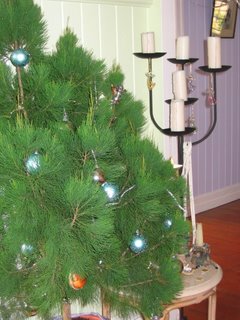
On Christmas Trees and Carols
The Christmas Tree
I have a Christmas tree. After many years without one, I now have a Christmas tree - not a plastic one, not a chopped down one, but a real, living tree.
My childhood memories of Christmas include the Christmas tree. We always had an Australian native tree and I can still smell its fragrance, so typical of the Australian bush, and see the exquisite glass tree decorations. I also remember that it seemed to attract mosquitoes in their hoards. But that’s part of a tropical Christmas anyway.
Over the years I went through my ‘intellectually liberated’ phase and denigrated the Christmas tree as commercialisation and after all, just a pagan import and a left-over from the Victorian era. Also it was a product of northern hemisphere celebrations, so what did it have to say for us in Australia. What a sour, desiccated and one dimensional view I had.
The Christmas tree is all that but there is another side that it celebrates. All good things are open to exploitation but that does not discount their power and goodness. I still feel strongly that we need to find Australian symbols (and validate those we already have) to enrich our celebration of these great feasts, that is why I went out and bought myself a Christmas tree.
The wonder of it is that it is a Daintree Pine. To quote the nursery tag, it is ‘a rare native pine from World Heritage forests of Far North Queensland. Fossil records show the Daintree Pine dates back to the Gondwana period’. For me, it symbolises this very ancient land that is now Australia. As Gondwana travelled the globe and eventually broke up into the land masses we now know, this pine was growing. It survived climate changes of cataclysmic proportions, geological upheavals and the arrival of human beings.
For me, it is a fitting symbol of what we celebrate during this liturgical season – enduring hope.
It is fitting that our Christian symbols are symbols that are found across many cultures and religions, because that’s the nature of symbols. Symbols are a language that speaks to the deepest longings, hopes and aspirations of humans. Because of this, they have the power to speak in different times and places. They break open new meanings as our consciousness changes. They have the power to synthesise many facets of meaning. (Symbol comes from the Greek sym – ballon which means to throw/bring together.)
So my evergreen Daintree Christmas tree links this celebration of Christmas – God’s commitment to all creation through Incarnation – with earth’s earliest times of creation; with cultures where the tree meant survival (literally) and symbolised the link between heaven and earth; life and hope.
As a Christian symbol it draws all that together in Jesus, the Branch of the tree of Jesse – the One who brings new life and hope always renewed. The evergreen tree (a deciduous tree has another meaning) says that life continues even in the harshest to times, just as God’s creating, loving presence abides even in our harsh times, that when we keep grounded in the soil of our deep purpose in God, we remain green and flourishing.
On Christmas Carols
This week I attended the Festival of Carols and Readings at the Cathedral. It was a feast of contemporary and traditional carols and Scripture readings. We in the congregation, got to sing the familiar carols which we did with great gusto.
I was reminded of one parish I attended some years ago in which the music co-ordinator decided to abolish all traditional Christmas carols because they were ‘theologically incorrect’. I have to tell you that midnight Mass was far from festive.
As we sang, listened, prayed and remembered, I began thinking about how important repetition and the familiar are for us human beings. We live in a society that idolises that which is new – as soon as you buy a new computer it seems to be out of date. This is not necessarily bad. Our ability to change is absolutely integral to maturity, both individually and as a species. However, we also need the familiar, and repetition is part of that familiarity. It is an important part of a spiritual discipline.
On a psychological level, we are constantly telling ourselves about ourselves. It’s called self-talk. That may be positive or negative given the situation or our background.
The spiritual discipline of repetition may be learning texts from the Scripture, learning prayers, learning short phrases or traditions like the Rosary or the Jesus Prayer. Its aim is to change our consciousness, to give us resources of mind and heart upon which to draw in daily life in order to uplift our spirits, be patient with annoyances, focus on what is important and so on.
However, it has another function. The familiar had the ability to open us to newness. Boredom has the power to bring insight. I remember reading in G.K. Chesterton’s Napoleon of Notting Hill to the effect that if you see something ninety-nine times, on the hundredth time you are in danger of seeing it for the first time. That’s what happens when that which is familiar has gone through the process of being learned to the extent that we don’t ‘see’ it anymore; through the boredom threshold; to a moment of ‘Ah!’ Seeing it filled with new meaning.
So, as we sang our familiar carols – words we sing every year, with images that have accrued to this festival over two millennia – I saw that what was seen as just another baby being born was, in truth shattering Mystery enveloped in the Ordinary, that always the Ordinary is pregnant with God - and that is why angels do sing on high and wise people follow a star.

No comments:
Post a Comment